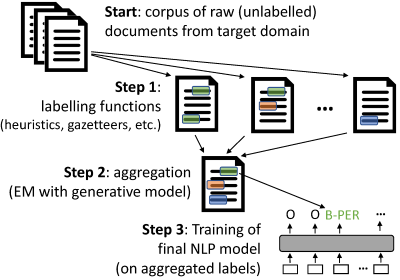-
Notifications
You must be signed in to change notification settings - Fork 73
Home
Pierre Lison edited this page Apr 16, 2021
·
10 revisions
skweak a versatile, Python-based software toolkit enabling NLP developers to apply weak supervision to a wide range of tasks, and in particular sequence labelling and text classification. Instead of labelling data points by hand, we define labelling functions to automatically annotate text documents from the target domain. The results of those labelling functions are then aggregated into one single annotation layer using a generative model.

As shown above, weak supervision with skweak is divided in several steps:
-
Start: We must first prepare the(unlabelled) corpus onto which the labelling functions will be applied.
skweakis build on top of SpaCy, and operates with SpacyDocobjects, so you first need to convert your documents toDocobjects withspacy. - Step 1: We then define a range of labelling functions that will take those documents and annotate spans with labels. Those labelling functions can take a variety of forms, from handcrafted heuristics to machine learning models, gazetteers, etc.
-
Step 2: Once the labelling functions have been applied to your corpus, we aggregate their results in order to obtain a single, probabilistic annotation (instead of the multiple, possibly conflicting annotations from the labelling functions). This is done in
skweakusing a generative model that automatically estimates the relative accuracy and possible confuctions of each labelling function. - Step 3: Finally, based on those aggregated labels, we train our final model. Step 2 gives us a labelled corpus that (probabilistically) aggregates the outputs of all labelling functions, and you can use this labelled data to estimate any kind of machine learning model.